OVERALL REVIEW OF FY 2003
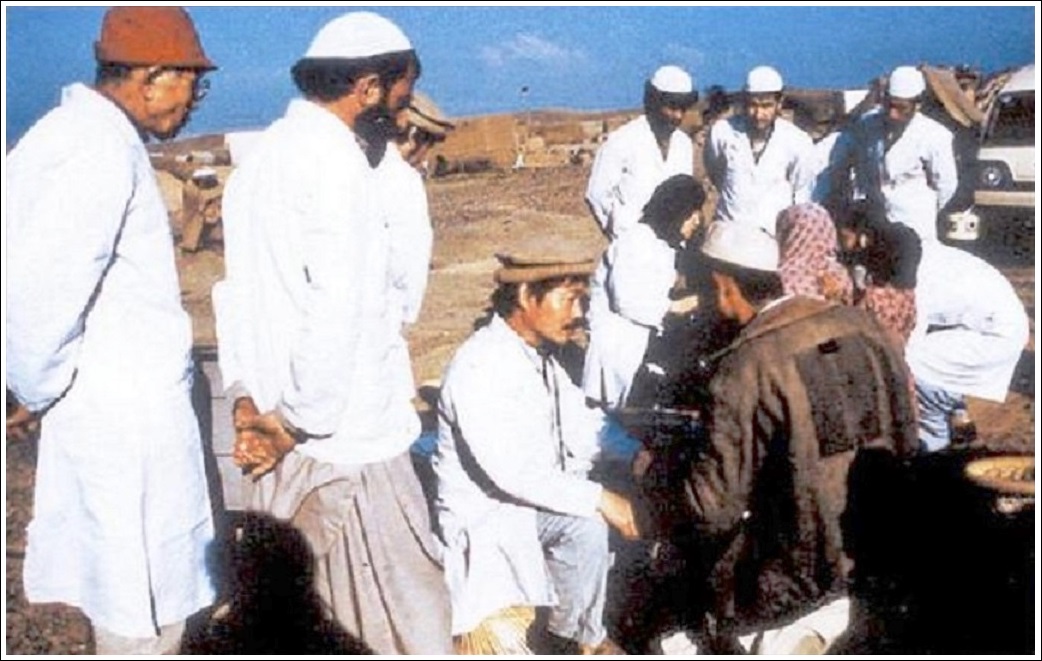 |
▲Tetsu Nakamura,center,examines sick people an
Afghan refugee camp in northwestern Pakistan. |
The year 2003 marks the 21st anniversary of Peshawar-kai. The U.S. air strikes against Afghanistan in October 2001 followed by military operations that took place under the name of the 「War on Terror」shook the international society. To this drought hit country came destruction followed swiftly by reconstruction aid.
The U.S. asserted that their military actions were to promote democracy and prevent terrorism in Afghanistan and persuaded other developed nations to support their mission. The justification of their cause in this manner gave them license to go on a rampage in the Islamic nations, especially in Iraq and Palestine. Experts warned the「War on Terror」and the imposition of democracy by military force would only produce a massive number of would-be terrorists. This warning proved to be correct. In fact, except those of the urban middle class who are benefiting from the reconstruction assistance money, very few people are happy about the presence of the U.S. and foreign troops in the eastern part of Afghanistan.
Afghanistan was once seen as a model for the U. S. invasion of Iraq, but it receives little attention from the world today. Optimistic reports on the nation's reconstruction efforts gave the world a false impression that democratization was making a steady progress. As a result, Afghanistan has gradually faded from the world's attention. In reality, however, the U.S. and its allies have continued military attacks against Afghanistan.The U.S. military believed Al-Qaeda and Taliban supporters were seeking refuge in autonomous tribal areas in the North West Frontier Province of Pakistan and began large-scale military operations in the fall 2003. However, local residents in the areas showed strong resistance, and the current situation in the border areas, including Nangarhar, Lowgar and Kandahar Provinces in Afghanistan is chaotic.
Additionally, the U.S. military, now stretched thin due to the invasion and quelling of Iraq, is eager for some tokens of success and has begun interfering in Afghanistan's civil affairs. While pressing the NATO allies to play a military role in Afghanistan, the U.S. in cooperation with the UN is spending $800 million to engineer the September 2004 general election. The locals ridicule this effort calling it「a Trinity of British trickery, U.S. military power and Japanese money」. I am afraid the Afghan people's anti-Japan sentiment is going to further intensify.
When the deployment of the「Japanese military」(the Self Defense Forces) to Afghanistan was reported in the local news in May 2004, distrust toward Japan quickly spread among the Afghans. As a result, the Peshawar-kai Medical Services (PMS) had to make a painful decision to paint out the Japanese national flag of the rising sun and replace it with a green flag. I felt humiliated as a Japanese national.
In November 2003, a U.S. helicopter raided a construction site where the PMS was building an irrigation channel. This was only one of many erroneous air bombings carried out by U.S. military forces. In Afghanistan, hostile feelings against foreigners are growing among the locals as they learn not only about the increasing number of casualties resulting from erroneous bombings, but also the torture of Afghan POW's and the spraying of chemical herbicides over their farmlands.
It seems practically impossible to hold a general election in Afghanistan under the current circumstances. The hardship of an estimated 1.6 million Afghan refugees in Pakistan has not been alleviated. Most of the returnees have faced hunger in their villages and have had to return to their shelters in Pakistan. Sporadic reports from the country have been limited to accounts of what is happening in major cities, such as the capital, Kabul, and have focused on merely political development. Furthermore, with more than 70% of the overseas assistance being distributed through the U. N. and foreign NGOs, the U.S.-backed Afghan government is unable to pay salaries to its already underpaid public servants. As a result, the Karzai administration has had to appeal for direct assistance from donors so that funds could reach his government without having to go through aid organizations. Other reconstruction efforts such as antinarcotics operations, the establishment of a national army and demilitarization are not making visible progress either.
The drought in central Asia began posing a serious problem in 2000 and it is getting even worse in its fourth year. The United Nation's World Food Program (WFP) predicted the greatest harvest in 30 years in April 2003, but the forecast turned out to be false when there was only a slight increase in rain in the area and almost no wheat was harvested. Snowfall in high mountains was expected to increase in December 2003, but the increase was negligible. It is feared that the ongoing drought and desertification will escalate in 2004. In fact, the wells that PMS had constructed in the past are drying up, one after another, and the water table is lowering at an unusually fast pace at many sites. Considering that 80% of the country's population is made up of farmers, it seems almost certain that the collapse of Afghanistan will be caused by problems of climate, i.e. desertification, not by war or political problems.
Policymakers and foreign aid organizations should be alarmed by the seriousness of the drought, especially since the drought did not happen overnight but has been gradually worsening over a decade. If the drought continues, farming villages- which are the backbone of this country- will further disintegrate and starving refugees will flood into the big cities. These destitute people will not make the news since they do not tally with optimistic reports on Afghanistan's ongoing reconstruction. As their living condition deteriorates, the common laws and social mores in rural areas- which play a big role in sustaining morals in Afghan society- will be gradually neglected and foreign-made「democracy」may be imposed on them. If that happens, this country will definitely plunge into chaos. In my view, without stabilizing the basic quality of life for ordinary Afghan people, no security improvement or nation-building will be accomplished.
Overall Review of PMS Activities
Since the summer in 2000, PMS has been heavily engaged in securing sources of drinking water and had dug over 1,000 wells before June, 2003. In rural areas of Afghanistan, agriculture is the sole means of earning a living. Without agricultural water, villagers can't return and reconstruct their lives in their villages. Therefore, we commenced the Green Ground Project to secure an agricultural water supply in fiscal 2003.
Prior to the project, we had previously revived the karez system and excavated wells for irrigation. In March 2003, we started the construction work of a 14-kilometer-long canal. As of March 2004, the hardest part of the canal? a two kilometer stretch- has been completed and the rest of the project is now underway.
While remaining deeply involved in the water supply project, we continued our medical work in 2003 as we have in past years. Our clinics remained open in Lasht, the northernmost town of Pakistan; Dara-e-Noor and Dara-e-Pech, mountainous villages in eastern Afghanistan; and Dara-e-Wama in the Afghan Province of Nuristan. In these remote villages, our commitment of 13 years in medical services has rendered an unshakable bond between the local population and PMS. We should not forget that our supply of water and agricultural projects would have been impossible if there had not been this relationship of mutual trust. The new building for the Okinawa Peace Clinic in the Dara-e-Pech Valley was completed in September 2003 and the operation was moved to this location by December.
At our experimental farm in Dara-e-Noor, research work on crops with dry resistance and experiments on cash crops including tea are being carried out. Unfortunately, these projects are not making as much progress as we had hoped because the impact of the drought has been greater than we anticipated.
The fiscal year 2003 saw an increase in the number of Japanese workers. In particular, young men in their twenties contributed a great amount of time and labor to our activities throughout the year.
FY 2003 REPORT AND FY2004 PLAN
Medical Project
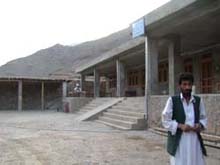 |
| ▲Okinawa Peace Clinic |
A total of 160,389 patients received our medical care in fiscal 2003.For more details about the main hospital in Peshawar and all other clinics, please refer to Tables 2 and 3 [omitted].
The construction of the Okinawa Peace Clinic was completed in September 2003. During the construction and relocation of this clinic, we encountered difficulties as the U.S. intensified its military operations in Afghanistan.Currently, the Wama clinic is being renovated and an extension is being added to the Lasht clinic.
During the year, PMS's main hospital experienced a temporary crisis when many of the doctors, nurses and laboratory technicians moved to Kabul for higher wages. The increase in Japanese staff required additional attention and care. Furthermore, the procurement of heavy machines, equipment and materials for the canal construction added extra work.
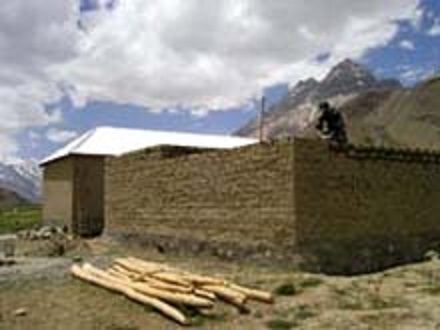 |
| ▲Lasht clinic |
Nevertheless, we managed to maintain our medical services at the usual level. Mr. Nakayama, in charge of accounting, Dr. Nakachi, the chief of the medical staff, and Ms. Sakao, laboratory technician have, under the guidance of Ms. Fujita, the Deputy Director, become our reliable long-term workers. This may well be the year's biggest achievement.
For the numbers of patients who received medical care at each hospital and clinic in fiscal 2003 (April 2003 through March 2004), please see Table 1 [omitted].
A total of 34,076 cases were tested at our main hospital's laboratory. For more details, please see Table 4 [omitted].
2. Drinking Water Supply Project
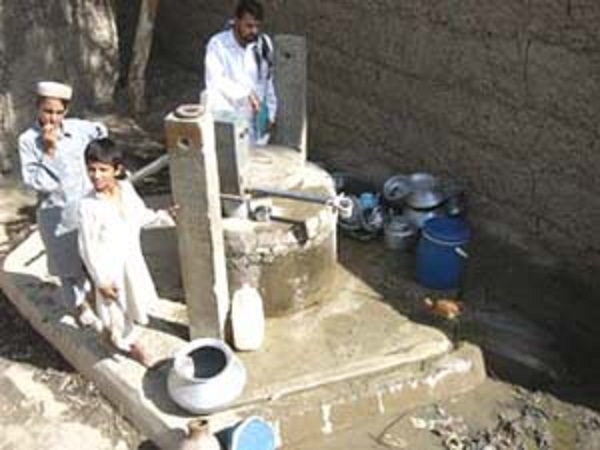 |
| ▲Well |
The project began near the Dara-e-Noor clinic in July 2000. The area was severely hit by drought. The project continued even under the U.S. air strikes. The number of our work sites exceeded 1,000 in June 2003 and it recorded almost 1,200 as of June 2004. The downstream region of Dara-e-Noor now has the most abundantly sourced supply of drinking water in the area. As a result, the number of intestinal infections has decreased drastically in the region and the majority of the villagers have returned from Pakistan. In Torkham (Khyber Pass), a water supply system has been installed. The system is now managed by the local residents' association. Self-management by its users is an ideal approach for sustaining a water supply system. The newly installed water system is capable of supplying water to several hundred households in the entire bazaar area. I am awestruck to recall the hell-like situation they went through during the time of water shortage three years ago.
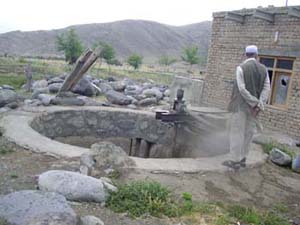 |
| ▲Irrigation Well |
However, lack of water is becoming ever more serious in other areas due to the lowering of the water table and the increase of returnees. We plan to extend our water supply project to Sorkh Rod District, Sheiwa District's northern part and the upper Dara-e-Noor. These districts have the largest population in the area and are being badly hit by the drought. The major part of the work involves re-excavation of dried wells. Drilling work is also on the rise. The numbers of wells and karezes we are currently working on are shown in Table 5 [omitted].
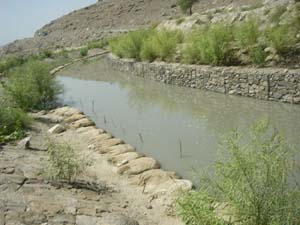 |
| ▲Irrigation canal |
We plan to continue our water supply project exclusively in Nangarhar Province, the hardest hit by the drought, and we aim at digging a total of 2,000 wells in the next three years. It was clear that we would not be able to manage all the wells we dug as we continued to excavate more wells. Therefore, in fiscal 2003, we gradually started to hand over the completed wells to the local residents. From now on, we would like to further promote the transfer of the management of the wells to the villagers. In future reports, our work on irrigation wells and karezes will be included in our irrigation project together with the canal project.
3. Irrigation Project
(1)Karez:
So far, 38 sites have been restored in the middle and lower basin of Dara-e-Noor and water is running at all of the sites. An estimated 400 to 500 hectares are benefiting from the revived karazes. However, this year saw a drastic decrease in the water level and we will continue to monitor the situation.
(2) Irrigation Wells:
We experimentally excavated large-diameter wells in June 2001 and confirmed one well is able to supply water sufficient for the irrigation of approximately 25 hectares. In 2003, we started the construction of 11 wells in the lower basin of Dara-e-Noor. Budialy village and Soregi village had not benefited from the restored karezes. Nine out of the eleven wells have been completed. These wells supply water for 200 hectares of land in the area. So far, a noticeable decrease in the water level has not been detected. However, it is expected that the water level may gradually decrease. Conflicts over water among residents are already occurring. Therefore, we will refrain from building wells at a rapid pace. Instead, we will construct an irrigation canal and draw water from the rivers mentioned below. After that, we will review our water supply project.
(3) Irrigation canal:
Our plan is to draw water from the Kunar River, the largest river in eastern Afghanistan, and to irrigate the drought-hit areas in the northern part of Nangarhar Province (These areas used to obtain their water from the river system of Dara-e-Noor), the whole region of Kuz Kunar, the lowest river region of Budialy village and the northern part of Sheiwa District.
This 14-kilometer long canal will supply water to over 2000 hectares. The estimated flow rate will be 4 to 5 tons per second. If it becomes possible to double-crop wheat and corn with the help of the canal, over 100,000 people, including children, will be fed. The construction started on May 13, 2003. After some twists and turns, the two kilometers from the intake has been completed so far. Currently, effort is being concentrated on the next three kilometers, the hardest part of all. The construction work has been placed under the direct control of the PMS main hospital. When the canal is completed this summer, it will be able to supply water to approximately
500 hectares, two thirds of the whole Kuz Kunar area.
Hearing about the ongoing irrigation work, the area's farmers, who have fled to Pakistan's North West Frontier Province as refugees, are gradually returning to their villages. Currently, more and more desolated houses are being renovated in the area. The total number of people who worked in this project in fiscal 2003 is about 140,000. The majority of the workers are farmers who await the water supply for their land. The first construction phase of the 14-kilometer long canal is scheduled to be completed by the end of fiscal 2004. After that, we plan to continue improving and reinforcing the canal and hand it over to the Afghan government and the local residents' autonomous association within three years.
4. Agriculture Project
 |
| ▲Sweet potatoes |
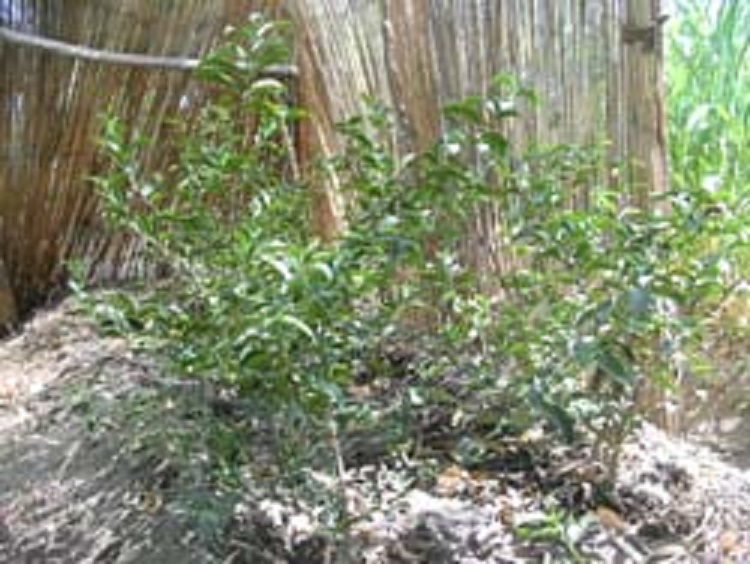 |
| ▲Tea |
Many experimental projects are being carried out at our experimental facility in Dara-e-Noor. Our main focus is a biannual crop of wheat and corn, but we became more hopeful about growing sweet potatoes in 2003. At the moment, further efforts, such as soil improvement and the selection of suitable products, are being made in order to increase the harvest of crops. In some areas, we are testing the growing of cash crops such as fruit and tea. We are also experimenting on silage fodder such as Sorgo.
Unfortunately, this project did not receive enough attention as the Japanese staff became extremely busy with the canal construction in December 2003. This project needs to be reorganized.
5. Japanese Workers
As our projects expanded, more Japanese workers were recruited and assigned to the respective positions. It usually takes a person more than a year to get used to a new environment and work assignment. Therefore, we decided the duration of assignment for Japanese staff should be more than two years and we would call them「workers」, not「volunteers」.We will try to increase the number of Japanese long-term workers. Independent of this, we will continue to send specialists and experts for several months at a time on a regular basis. In fiscal 2003, we dispatched the Japanese workers listed in Table 6 [omitted]. Our policy is to send a candidate worker on a temporary assignment for three months at first and then decide whether he or she should remain on a long-term mission or not.
by Tetsu Nakamura,
Executive Director, Peshawar-kai Medical Services (PMS).
* Excerpt from Peshawar-kai News Letter #80 issued on 7 July 2004.
|






